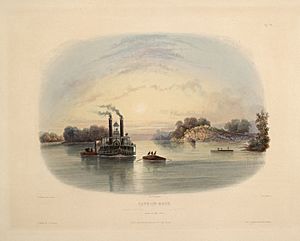Cave-In-Rock, Illinois facts for kids
Quick facts for kids
Cave-In-Rock
|
|
|---|---|
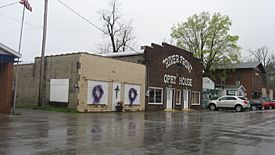
Main Street of downtown Cave-In-Rock, Illinois in 2013
|
|
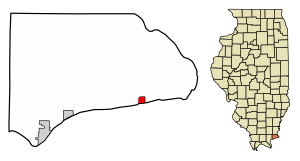
Location of Cave-In-Rock in Hardin County, Illinois.
|
|

Location of Illinois in the United States
|
|
| Country | United States |
| State | Illinois |
| County | Hardin |
| Founded by | Earliest known permanent settlers arrived in 1816 |
| Named for | The Cave near the town |
| Area | |
| • Total | 0.41 sq mi (1.07 km2) |
| • Land | 0.37 sq mi (0.97 km2) |
| • Water | 0.04 sq mi (0.11 km2) |
| Elevation | 390 ft (120 m) |
| Population
(2020)
|
|
| • Total | 228 |
| • Density | 609.63/sq mi (235.65/km2) |
| Time zone | UTC-6 (CST) |
| • Summer (DST) | UTC-5 (CDT) |
| ZIP Code(s) |
62919
|
| Area code(s) | 618 |
| FIPS code | 17-11826 |
| GNIS feature ID | 2397577 |
| Wikimedia Commons | Cave-In-Rock, Illinois |
Cave-In-Rock is a small village in Hardin County, Illinois, United States. It's famous for a natural cave nearby, called Cave-In-Rock, which sits right on the banks of the Ohio River.
The first known settlers arrived here in 1816 and began building a town. It was first called Rock and Cave, Illinois. Later, on October 24, 1849, its name was officially changed to Cave-In-Rock. The village became an official village in 1901. In 2020, about 228 people lived there.
Contents
Where is Cave-In-Rock Located?
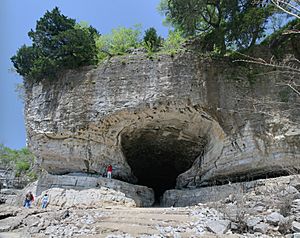
Cave-In-Rock is in the southeastern part of Hardin County. It's right next to the Ohio River, which forms the border between Illinois and Kentucky.
A special boat called the Cave-In-Rock Ferry helps people and cars cross the Ohio River from Cave-In-Rock village to Crittenden County, Kentucky. This village is also the starting point of Illinois Route 1, a long road that goes all the way north to Chicago.
The village covers about 0.42 square miles (1.07 square kilometers). Most of this area is land, with a small part being water. The area around Cave-In-Rock has interesting rock formations and valleys, formed over many years by nature.
Who Lives in Cave-In-Rock?
| Historical population | |||
|---|---|---|---|
| Census | Pop. | %± | |
| 1910 | 306 | — | |
| 1920 | 349 | 14.1% | |
| 1930 | 430 | 23.2% | |
| 1940 | 486 | 13.0% | |
| 1950 | 550 | 13.2% | |
| 1960 | 495 | −10.0% | |
| 1970 | 503 | 1.6% | |
| 1980 | 468 | −7.0% | |
| 1990 | 381 | −18.6% | |
| 2000 | 346 | −9.2% | |
| 2010 | 318 | −8.1% | |
| 2020 | 228 | −28.3% | |
| U.S. Decennial Census | |||
In 2020, there were 228 people living in Cave-In-Rock. These people lived in 69 households, and 37 of these were families.
Most people in the village (about 93%) are White. A small number of people are Asian or from two or more races. About 1.3% of the population is Hispanic or Latino.
About 29% of households had children under 18. Many households (about 40%) were married couples. The average age of people living in the village was about 36.7 years old.
The average income for a household was $24,583. About 23.6% of the people in the village faced economic challenges.
The Famous Cave
The most important feature of Cave-In-Rock is its amazing cave. It's about 55 feet (17 meters) wide and sits right by the river. This cave was formed by wind, water, and even by powerful earthquakes that happened in 1811–1812.
A French explorer named M. de Lery was the first European to discover it in 1739. He called it "caverne dans Le Roc" (cave in the rock). Over time, it has been known by many names, like Rock-In-Cave and The Big Cave. Today, the cave is the main attraction of Cave-in-Rock State Park, which was created in 1929.
A Look Back in Time
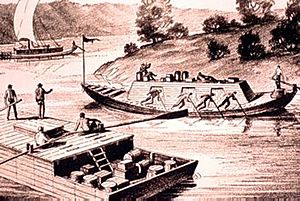
From the late 1700s to the late 1800s, the area around Cave-In-Rock had a reputation for being a place where outlaws gathered. Historians called them the "Ancient Colony of Horse-Thieves, Counterfeiters and Robbers."
In the 1790s, some people who made fake money, like Philip Alston and John Duff, used the cave as a meeting spot. Later, in 1797, a man named Samuel Mason made the cave a base for river bandits. These groups would trick travelers on the river, then rob and sometimes harm them.
Another person, James Wilson, might have been working with Samuel Mason. In 1799, he put a sign over the cave's entrance that said "Wilson's Liquor Vault and House for Entertainment." This was a trick to lure in unsuspecting travelers.
Soldiers from Fort Massac tried to capture some of these outlaws. In one event, John Duff and his men escaped from the soldiers at the cave. They tied up the soldiers and sent them floating down the river. Later, the commander of Fort Massac arranged for Duff to be killed.
Samuel Mason and Wilson's time at the cave likely ended in 1799. A group of people called "The Exterminators" attacked them. After this, Mason moved on to rob people on the Natchez Trace highway.
Later, other groups of outlaws were active in the region. The Sturdivant Gang made fake money, and the Ford's Ferry Gang led by James Ford robbed people a few miles upriver from the cave. Law enforcement worked to break up these gangs. The Ford's Ferry Gang ended after James Ford and his sons died in conflicts.
Even after these gangs were gone, some outlaws remained. Isaiah L. Potts ran an inn where travelers sometimes disappeared. There's a sad story about his son, Billy Potts, who was unknowingly killed by his own father.
In the mid-1800s, church services began to be held inside the cave. This group eventually formed the Big Creek Baptist Church, which was the first church organized in southeastern Illinois.
Cave-In-Rock became an official village in 1839. In the same year, Hardin County was created. In 1929, the State of Illinois bought 64.5 acres of land to create Cave-in-Rock State Park. The park has grown to 204 acres and features beautiful hills and bluffs overlooking the river.
Images for kids
-
Fluorite mineral specimen from Cave-in-Rock area
See also
In Spanish: Cave-In-Rock (Illinois) para niños


